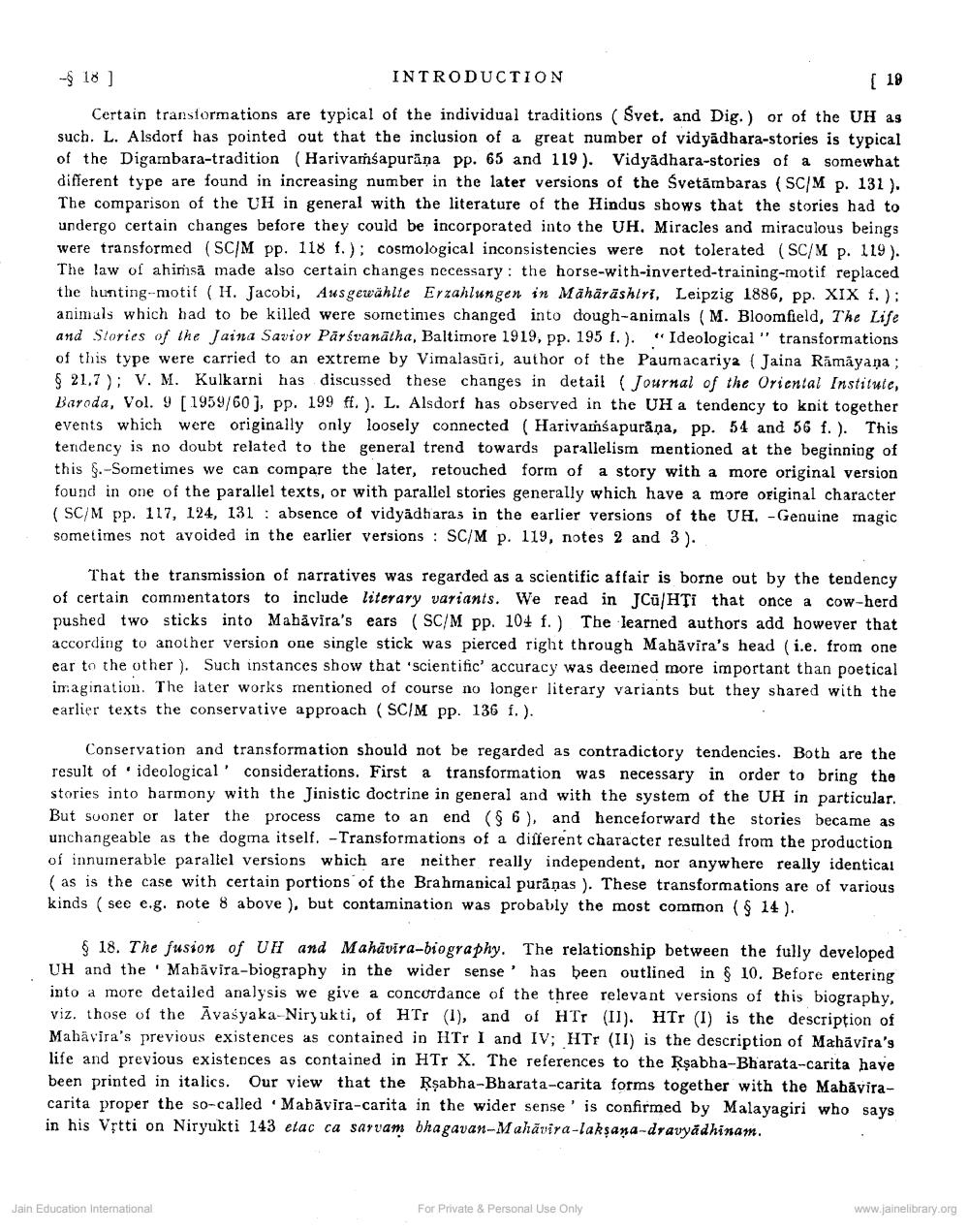________________
- 18 ] INTRODUCTION
[ 19 Certain transformations are typical of the individual traditions (Svet. and Dig.) or of the UH as such. L. Alsdorf has pointed out that the inclusion of a great number of vidyādhara-stories is typical of the Digambara-tradition (Harivamsapurāņa pp. 65 and 119). Vidyadhara-stories of a somewhat different type are found in increasing number in the later versions of the Svetämbaras (SCM p. 131 ). The comparison of the UH in general with the literature of the Hindus shows that the stories had to undergo certain changes before they could be incorporated into the UH. Miracles and miraculous beings were transformed (SC/M pp. 118 f.); cosmological inconsistencies were not tolerated (SC/M p. 119). The law of ahimsă made also certain changes necessary: the horse-with-inverted-training-motif replaced the hunting--motif (H. Jacobi, Ausgewählte Erzahlungen in Māhārāshiri, Leipzig 1886, PP. XIX f.): animals which had to be killed were sornetinies changed into dough-animals (M. Bloomfield, The Life and Stories of the Jaina Savior Pārsvanātha, Baltimore 1919, pp. 195 f.). "Ideological transformations of this type were carried to an extreme by Vimalasuri, author of the Paumacariya Jaina Ramayana : 6 21.7: V. M. Kulkarni has discussed these changes in detail (Journal of the Oriental Institute, Baroda, Vol. 9 [1959/60 ), pp. 199 ff.). L. Alsdorf has observed in the UH a tendency to knit together events which were originally only loosely connected (Harivaṁsapurăņa, pp. 54 and 56 f.). This tendency is no doubt related to the general trend towards parallelism mentioned at the beginning of this S.-Sometimes we can compare the later, retouched form of a story with a more original version found in one of the parallel texts, or with parallel stories generally which have a more original character (SC/M pp. 117, 124, 131 : absence of vidyadharas in the earlier versions of the UH. - Genuine magic sometimes not avoided in the earlier versions : SC/M p. 119, notes 2 and 3).
That the transmission of narratives was regarded as a scientific affair is borne out by the tendency of certain commentators to include literary variants. We read in JCü/HTi that once a cow-herd pushed two sticks into Mahāvira's ears (SC/M pp. 104 f.) The learned authors add however that according to another version one single stick was pierced right through Mabăvira's head ( i.e. from one ear to the other ). Such instances show that 'scientific accuracy was deerned more important than poetical imagination. The later works mentioned of course no longer literary variants but they shared with the earlier texts the conservative approach (SC/M pp. 136 f.).
Conservation and transformation should not be regarded as contradictory tendencies. Both are the result of ideological considerations. First a transformation was necessary in order to bring the stories into harmony with the Jinistic doctrine in general and with the system of the UH in particular. But sooner or later the process came to an end ($ 6), and henceforward the stories became as unchangeable as the dogma itself. Transformations of a different character resulted from the production of innumerable parallel versions which are neither really independent, nor anywhere really identical (as is the case with certain portions of the Brahmanical puräņas ). These transformations are of various kinds (see c.g. note 8 above ), but contamination was probably the most common ($ 14).
$ 18. The fusion of UH and Mahavira-biography. The relationship between the fully developed UH and the Mahāvira-biography in the wider sense' has been outlined in g 10. Before entering into a more detailed analysis we give a concordance of the three relevant versions of this biography, viz. those of the Āvasyaka-Niryukti, of HTr (1), and of HTr (II). HTr (I) is the description of Mahävira's previous existences as contained in HTr I and IV; HTr (II) is the description of Mahavira's life and previous existences as contained in HTr X. The references to the Rşabha-Bharata-carita have been printed in italics. Our view that the Rşabha-Bharata-carita forms together with the Mabăviracarita proper the so-called Mabăvira-carita in the wider sense' is confirmed by Malayagiri who says in his Vrtti on Niryukti 143 elac ca sarvam bhagavan-Mahāvira-laksana-dravyādhinam.
Jain Education International
For Private & Personal Use Only
www.jainelibrary.org




